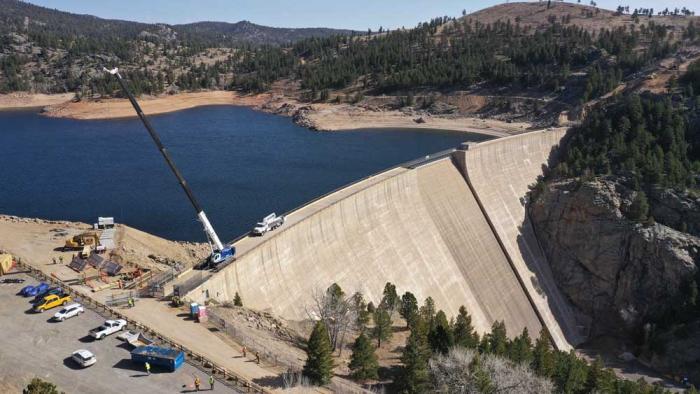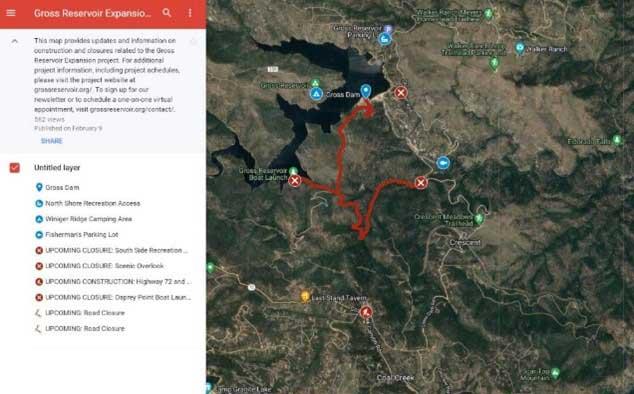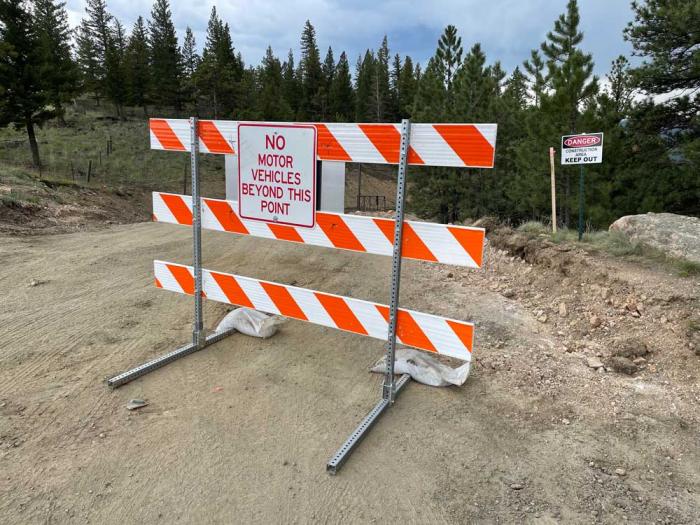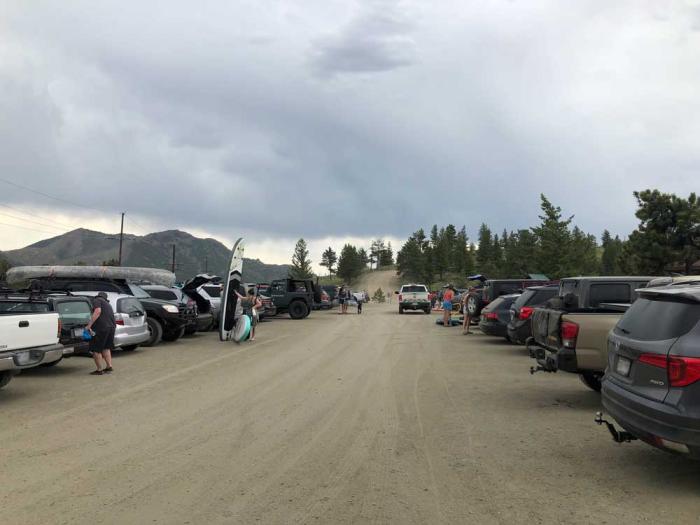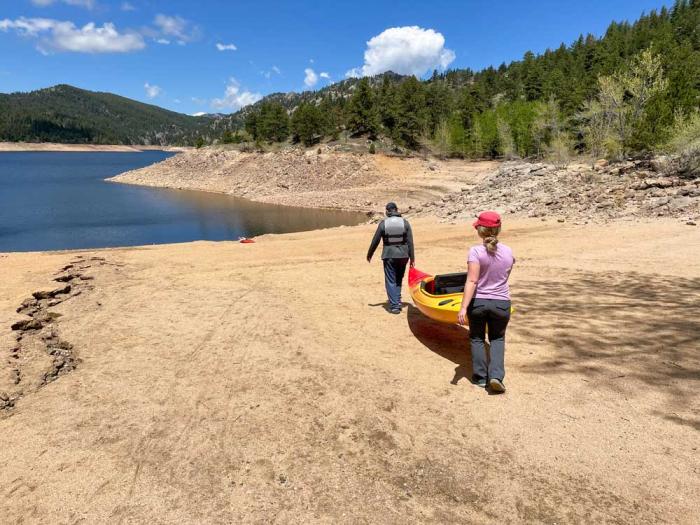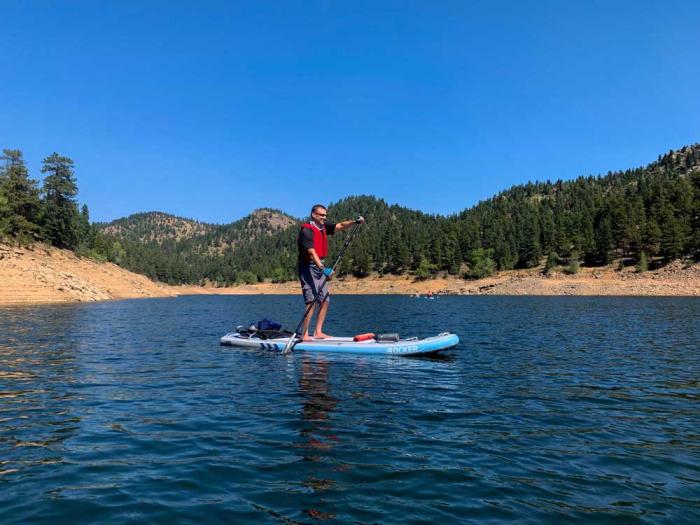Big changes for recreation at Gross Reservoir
Hiking, fishing and boating at Gross Reservoir will be different through 2027, as construction work on the Gross Reservoir Expansion Project impacts access to the recreation area in Boulder County.
“Denver Water recognizes that Gross Reservoir is a popular place, and our goal is to keep this recreational amenity open, as much as possible and in the safest way possible during the construction project,” said Brandon Ransom, manager of recreation for Denver Water.
On April 1, 2022, Denver Water began construction work to raise the height of Gross Dam northwest of Denver by 131 feet and nearly triple the water storage capacity of the reservoir.
Due to construction activity during the five-year construction project, the south side of the reservoir is closed to the public through 2027.
Closed during the construction project:
- Osprey Point boat launch and South Boulder Creek Inlet Trailhead.
- South Shore and Windy Point picnic and fishing areas.
Open during the construction project:
- North Shore Picnic Area, boat ramp and parking lot at the intersection of Gross Dam and Flagstaff roads.
- South Boulder Creek Outlet Trail below the dam.
- Winiger Ridge Campground. (The campground is typically open mid-May through October. Some temporary closures are expected starting in 2025.)
- Forsythe Canyon Trailhead hiking. (Some temporary closures are expected starting in 2025.)
If you visit Gross Reservoir during the expansion project, pay attention to all posted signs around the site and obey on-site personnel when they give notices and alerts.
Changes to boating, parking and capacity
During the project, recreation access for boating, fishing, hiking and picnicking will shift to the reservoir’s free North Shore Picnic Area.
Boating season runs from the Friday of Memorial Day weekend through Sept. 30 for human-powered watercraft, including canoes, kayaks and paddleboards.
Denver Water expanded the free parking lot on the reservoir’s north side to account for the loss of parking on the south side.
However, Ransom said he expects the North Shore lot will reach capacity early in the day on busy weekends and is likely to remain full most of the day as there are only 100 parking spots available.
Visitors will be turned away when the parking lot reaches capacity.
No street parking is allowed near the North Shore parking lot for safety reasons, and visitors who park illegally in the parking lot or along the road are subject to parking tickets and having their vehicle towed.
Ransom encouraged visitors to carpool to free up parking spots and visit on weekdays to avoid crowds.
Getting to the water
The walk from the North Shore parking lot to the lower recreation picnic area is roughly 1/3 of a mile in length. The walk to the water could be longer by several hundred additional feet depending on the reservoir’s elevation.
Visitors can walk down a steep single-track trail. Walking down the service road is not permitted. Cars are not allowed on the service road due to construction activity and safety concerns.
Share this information; forward this story. Did you get this from a friend? Sign up here for Denver Water’s free, weekly TAP email.
Again this season, Denver Water will offer a free shuttle bus that will run from the North Shore parking lot to the lower recreation site. The shuttle will have a trailer to haul boats down the hill.
During the 2023 season, starting May 26, the shuttle is scheduled to operate Thursday through Monday from 8 a.m. to 5:45 p.m. There is no shuttle service on Tuesdays or Wednesdays. The shuttle program will be evaluated throughout the summer for effectiveness and changes will be made as needed.
Water levels and safety
Visitors should be prepared for lower water levels at the reservoir throughout construction, as the reservoir will be filled to about two-thirds of its existing capacity to maintain safe operations for construction workers.
Swimming is not allowed in Gross Reservoir. Ransom reminds boaters that a life jacket approved by the U.S. Coast Guard is required to be on board for each passenger in case they accidentally fall in the water. Children 12 and under must wear life jackets at all times.
“The water is always cold in Gross Reservoir, so we strongly recommend everyone wear their life jackets,” Ransom said. “It’s also important to be aware of the gusty winds and afternoon thunderstorms that are very common in the foothills.”
Another reminder is that pedal boats, inner tubes and floatable rafts designed for pools are not permitted on Gross Reservoir. Motorized vessels also are not allowed.
Know before you go
“We are proactively communicating with recreationists via signage, traditional media, websites, email newsletters and social media, among other means — and we strongly encourage visitors to check these channels before heading to Gross Reservoir to ensure they are aware of any closures or changes,” Ransom said.
As the project moves forward, there also will be periodic on-water recreation and campsite closures to keep recreationists safe.
The closures may be needed during rock blasting near the dam and a quarry area on the southeast corner of the reservoir. Closures will be temporary, and every effort will be made to alert the public to closure periods ahead of time.
If you visit Gross Reservoir during the expansion project, which goes through 2027, pay attention to all posted signs around the site and obey on-site personnel when they give notices and alerts.
A consistent place to get up-to-date information on the expansion project will be through the project website grossreservoir.org, as well as via a Google My Map.
The public also can contact Denver Water through email, a phone line and virtual office hours, as well as by signing up for email updates and following the utility’s social media channels. Contact information and other details are available at the Denver Water website as well as on the project website. Denver Water’s TAP news site also includes stories about the expansion project.


